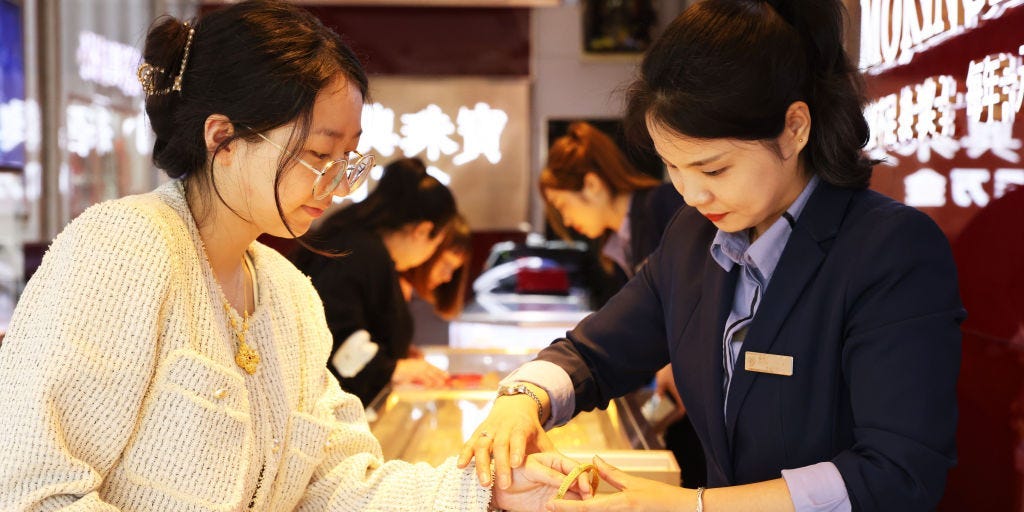
The consumption trend reflects risk hedging and a lack of confidence in the flagging economy that has been struggling to regain momentum since lifting on-off pandemic lockdowns.It also reflects that there’s money in the system — but Chinese consumers are just really not that keen on dropping their hard-earned cash at Starbucks or Gucci.China’s economy is facing multiple risks and uncertainties, including an epic real-estate crisis, stock market volatility, geopolitical headwinds, and demographic challenges.”With China’s population facing rapidly aging demographics, Chinese households are trying to boost their retirement savings at a time when real estate and equity markets have been weak,” Rajiv Biswas, an international economist and the author of “Asian Megatrends,” told Business Insider.Last year, China’s demand for gold jewelry rose 10% from 2022, to 630 tons acquired, making the country the world’s largest buyer of the commodity, according to the World Gold Council. China’s demand for gold jewelry softened in the first quarter of this year due to the surge in gold prices but was still holding up well, according to the council.Gen Z Chinese consumers ditch luxury for goldUnlike the rush into gold assets, Chinese consumers are not running out to buy even more stuff, particularly foreign imports.This is a problem, particularly for luxury retailers, as China’s demand for high-end products fueled supercharged growth in the industry for years.This is no longer the case.LVMH Moët Hennessy Louis Vuitton, the world’s largest luxury group, reported in April that Asia’s revenues outside Japan fell 6% in the first quarter compared to the same period a year ago.Kering, the luxury retailer that owns brands including Gucci and Yves Saint Laurent, issued a profit warning due to the challenging market in China.In a reflection of how many shoppers fell out of luxury buying, Chinese shoppers were responsible for about 23% of luxury goods spending at the start of the year — down from 33% pre-pandemic, a Bloomberg analyst said recently.China’s consumers are buying cheaper domestic productsEven imports are taking a hit, with coffee chain Starbucks signaling a slower-than-expected recovery in China will lead to lower annual growth this year, the company reported in April.Starbucks CEO Laxman Narasimhan said in a first-quarter earnings call that many customers are being “more exacting about where and how they choose to spend their money.”
Nomura analysts highlighted in an April report that younger Chinese consumers have become “much less enamored with foreign premium products, and now seem to prefer low-cost domestic substitutes.”In the case of Starbucks, Luckin Coffee — China’s biggest coffee chain — is aggressively putting out beverage deals at attractive prices to beat the American company.Patriotism is also playing into the trend. That’s true even for some products that are around the same price as imported ones, such as a recent surge in Huawei phone deliveries amid plunging iPhone sales, and a similar trend with Tesla versus BYD electric vehicles, the Nomura analysts added.China’s painful economic transition, which is causing a bumpy economic outlook for its people, is contributing to this trend.”As income growth slows, coupled with heightened unemployment risks, the high premium paid for foreign brands has become increasingly hard to justify,” wrote the Nomura analysts.China’s per capita GDP is still expected to riseDespite the gloom, there are green shoots in China’s economy.April data out of China showed consumers in the country are buying fewer things — such as clothing, cosmetics, and jewelry — but they are spending on experiences.Consumption in the “eat, drink, and play” categories of catering, tobacco and liquor, and sports and recreation outpaced headline consumption growth. This signal shows that “consumers have been forgoing big-ticket purchases in favor of spending in these categories in 2024,” wrote Lynn Song, the chief economist for the Greater China region at the Dutch bank ING.This preference for experience spending also spills over to the consumer sector. LVMH CFO Jean-Jacques Guiony said in April that more Chinese are spending money outside their country as they resume traveling.Even so, Chinese consumers are still expected to retain their appetite for gold.GDP by capita in the world’s second-largest economy is also still expected to rise from $12,700 in 2023 to $18,000 by 2030 — which is likely to boost gold demand in the future, said Biswas, the economist.The weak Chinese yuan is leading consumers to buy gold with their savings to hedge against currency risks.China’s savings rate was around 32% last year — compared to around 4% in the US, according to a McKinsey analysis of official data.”As consumer sentiment continues its slump, consumers prefer to sock their cash away in the bank rather than spend it, pushing the savings rate higher,” McKinsey wrote in April.The spot gold price is around $2,335 per ounce, off the record high above $2,400 hit on May 21.There may be more upside for the yellow metal.”Chinese households are increasingly confronted by the weak long-term Chinese growth outlook and the slumping prices in China’s residential real estate market,” said Biswas.The economist said those woes will continue to drive investors, especially those looking to boost their retirement savings, to gold.






